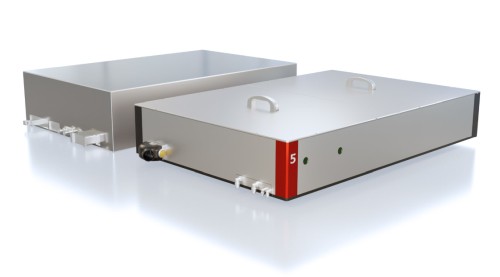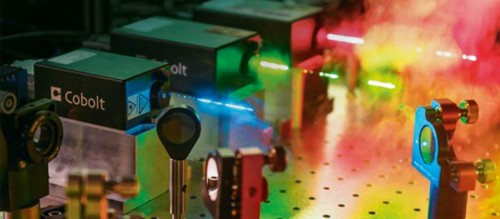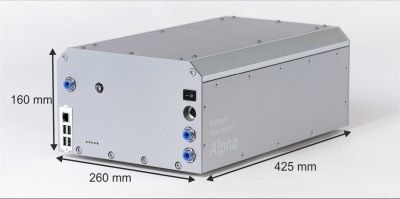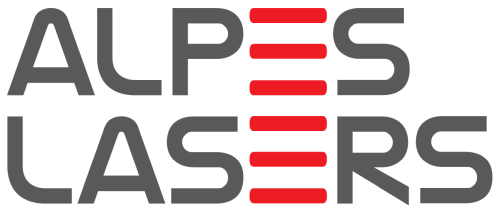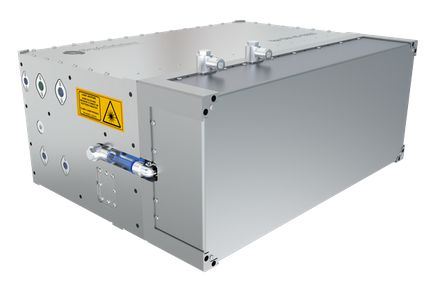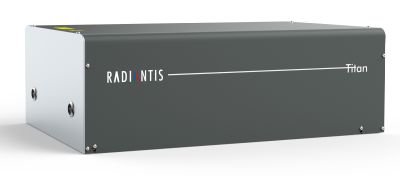laser specifications (original) (raw)
Definition: descriptions of essential properties of a laser system, such as performance parameters, dimensions, and operating conditions
Categories:  laser devices and laser physics,
laser devices and laser physics,  methods
methods
- laser specifications
Related: noise specificationslaser safetylaser applicationsindustrial lasersscientific lasersmedical lasers
Page views in 12 months: 770
DOI: 10.61835/mv3 Cite the article: BibTex BibLaTex plain textHTML Link to this page! LinkedIn
Content quality and neutrality are maintained according to our editorial policy.
📦 For purchasing lasers, use the RP Photonics Buyer's Guide — an expert-curated directory for finding all relevant suppliers, which also offers advanced purchasing assistance.
Contents
Purpose of Laser Specifications
For commercially sold lasers and laser systems, it is common to have a set of laser specifications, i.e., descriptions of their properties with some precision, as far as these are relevant for the users. (Internal details, which do not directly affect the user, are usually not specified.) Such specifications (in short: specs) are made by suppliers of lasers (usually by the manufacturers), but also a buyer will usually write down the required specifications for his application before selecting a laser model. Most aspects of this article apply both to certain laser components and to complete laser systems.
Laser specifications are important for different purposes, and are written by different players:
- The laser manufacturer needs to inform the buyer of a laser about the essential properties of a laser system before the laser is purchased and applied. Some key performance figures such as output power and beam quality normally need to be guaranteed, and various details must be known for proper application, for example for combining the laser with other devices.
- Specifications written by a buyer are often included in quotations and purchase orders to define duties of the supplier and conditions for use. In cases of conflict between user and supplier after purchase, specifications may be used to determine whether or not a laser system is delivering what it could be expected to deliver.
For most purposes, it is important that laser specifications are clear and precise, well understandable for all involved parties, and complete. In practice, specifications are often deficient concerning one or several of these aspects because insufficient know-how and experience was available for writing them, or the task was carried out with insufficient diligence. Such deficiencies can cause substantial technical and other problems. For example, incomplete specifications may make the selection of a laser complicated, create uncertainties for the application of a system, raise unrealistic expectations, or cause errors in the integration of laser products into other machinery. In cases of conflict, parties may insist on incompatible interpretations of unclear specifications or of the consequences of deviations, and this can contribute to expensive, time-consuming and risky legal conflicts.
Because such problems can be severe, a high degree of diligence is recommended
- when formulating specifications for an existing product,
- when defining the requirements for some application, and
- when determining whether a certain system will be suitable for an application.
However, certain important aspects are easily overlooked, particularly when no substantial experience with the type of devices or their application is available. For example, a user may not be aware of certain typical problems and limitations of certain laser types, while a manufacturer may not be aware of certain critical issues for an application.
Types of Specifications
Specifications can address very different aspects, such as performance figures, device lifetime, required ambient conditions, and other properties such as dimensions, weight and mounting details.
Performance Specifications
It is normally of central importance for the buyer of a laser system that certain performance figures are reached. What performance figures exactly are relevant, depends both on the details of the system and its application. Some typically important specifications concern the following aspects:
- The output power must stay within certain limits. Note that the output power may depend on additional conditions. For example, for pulsed lasers the average output power may depend on the chosen pulse repetition rate, and for tunable lasers it normally varies with the chosen wavelength.
- Various properties of the output laser beam need to be defined, in particular its transverse size: the beam radius (or diameter) at the exit from the laser housing, whether the beam is collimated, otherwise (for divergent or convergent beams) where the beam waist is located. Note that different definitions for the beam radius exist.
- The beam quality may be specified via the beam parameter product (BPP) or the _M_2 factor.
- The polarization may be linear with a given direction (vertical or horizontal). In other cases, the polarization is undefined, or rarely an unpolarized output is even guaranteed.
- For pulsed lasers, relevant quantities can be the pulse repetition rate, pulse energy and duration, pulse shape and for ultrafast lasers possibly a chirp. If the repetition rate can be varied, specifications of the other pulse parameters may be required for different values of the repetition rate. (For Q-switched lasers, for example, higher repetition rates normally imply lower pulse energies and longer pulses.)
- The laser wavelength (usually understood as the central vacuum wavelength, defined via the “center of mass”) must stay within certain limits. For tunable lasers, the accessible range of wavelength needs to be defined, and how other properties (e.g., the output power) vary in that range, or at least what minimum specifications are valid for that range.
- There is often an upper (and sometimes a lower) limit for the optical bandwidth, which is related to the temporal coherence of the laser light. One may also specify the limits for the coherence length. For example, a sufficiently short coherence length may be required to avoid problems with interference effects.
- Various kinds of fluctuations (laser noise) may be limited. For example, one may specify the maximum r.m.s. (root mean squared) fluctuations within a certain measurement bandwidth, possible in the form of relative intensity noise (RIN). Phase noise is related to the optical bandwidth (see above), but more comprehensive (frequency-resolved) phase noise specifications may be required in the form of a maximum power spectral density versus noise frequency. The beam pointing stability may be specified as an r.m.s. value of the angular deviations within a certain measurement time and bandwidth.
Often, specifications are valid only after a certain warm-up time after switching on a laser system.
Although this list contains all the typically relevant aspects, many additional aspects may also be relevant, depending on details of the laser system and the application.
Laser Safety
It is common to define a laser safety class for a laser source, even though the safety class for the system into which the laser is integrated may be completely different. If the output power exceeds a certain limit (depending on the wavelength) and the laser beam is accessible, the system will normally be in class IV (the most safety-critical one). If such a laser is put into a fully enclosed housing, with interlocks etc., the system may be in class I, where it can be considered as very safe.
Lifetime Specifications
Lasers, as other devices, have only a limited lifetime. The guaranteed lifetime may be specified as a certain number of years or via some number of operation hours, or possible both combined. It is normally understood as the time during which the laser fulfills all the performance specifications. A lifetime guarantee is often subject to additional conditions to be fulfilled by the user: Certain ambient conditions need to be ensured (see below), and regular servicing may be required.
Note that quite different interpretations of device lifetimes are possible. A strict interpretation would be that a laser system has to stay within specifications for the whole lifetime without any unplanned intervention. For a fiber amplifier, which is integrated into an undersea cable, this is very reasonable, since it is hardly possible to perform any service operations after deployment. For industrial lasers, however, occasional repairs may be tolerated, if they are not so frequent and/or time-consuming that they severely disturb the intended application. A rather lax interpretation of lifetime guarantee would be that the supplier can make as many repairs as required for reaching an overall long enough time of operation, and resulting interruptions and delays are not considered as problematic.
Ambient Conditions
Laser systems are often relatively sensitive to ambient conditions. Some typical aspects are shortly discussed in the following:
- The ambient temperature (air temperature and/or temperature of the table on which the system is mounted) must remain within certain limits. Deviations from that condition may lead not only to degraded performance but even to serious damage.
- If the laser housing is not hermetically sealed, there may be requirements on how clean the surrounding air needs to be, in what range the relative humidity needs to be, or whether purging e.g. with dry nitrogen gas is needed.
- Many lasers require a laser cooling units as a supply of cooling water, with conditions concerning the water pressure, the available water flow, and the chemical composition (e.g., pH value and salt content). While an interruption or insufficient strength of water flow should trigger an automatic system shut-down, an inappropriate chemical condition of the cooling water may lead to permanent damage. Microchannel coolers of laser diodes are particularly sensitive to effects of corrosion under such circumstances. Some isolated laser components or OEM laser modules may not have an automatic shutdown at excessive temperatures.
- Most lasers should not be exposed to excessive mechanical vibrations. Precise specifications in that respect are often not given, but at least some indication concerning how well a laser must be protected e.g. against vibrations caused by nearby machinery.
- Many laser devices are sensitive to back-reflected light; that may at least prohibit stable operation, although it may not lead to damage. It might be specified what level of reflections can be tolerated by the laser.
Other Properties
Various other properties of a laser system can be relevant, for example:
- the dimensions of the housing
- in the case of multiple parts (laser head, power supply, etc.): dimensions of all parts, cable lengths, etc.
- the weight
- the exact location where the generated laser beam leaves the housing
- types of fiber-optic connectors and/or parameters of the output fiber
- connections for additional parts such as interlocks
- electrical specifications for certain inputs (e.g. pulse triggers) and outputs
- accessibility of the housing e.g. for service operations
- details of the mounting and installation
- electrical power requirements, cable lengths
- service requirements, e.g. intervals for regular service and/or for replacing consumables
Of course, not all details may be given in some specification sheet; they may be provided only to those customers who ask for them.
Examples of Vague Laser Specifications
Many specifications which may look fairly clear at first glance can nevertheless be quite deficient. A few examples demonstrate that:
- “Output power: 25 W”: This is probably the lower limit; is there no upper limit? For a pulsed laser: It is probably the average output power, but is this valid for the full range of pulse repetition rates?
- “Pulse energy: 50 mJ”: probably a lower limit; does this only apply for a low enough pulse repetition rate?
- “Pulse pedestals: < 3%”: Is that a limit for the power or for the energy in pedestals?
- “Spot size: 2 mm × 1.5 mm”: Are these beam diameters in horizontal and vertical direction? Measured at which location — at the laser exit or at some focus position? Is it a full width at half maximum, or measured at ($1/e^2$) intensity level or whatever else?
- “Beam profile: TEM00”: Apparently, the beam is close to a diffraction-limited Gaussian beam, but how close? An upper limit for the _M_2 factor would be more precise.
- “Divergence angle: < 2 mrad”: Is this a full angle or half angle (i.e., against the beam axis)? Is it based on an ($1/e^2$) intensity criterion?
- “Output power stability: ±1%”: This is extremely vague: does it mean that the power always stays within ±1% of the average value? What is the measurement time and bandwidth? (Typically, larger fluctuations are recorded with a fast detector used over a long time.) A root-mean-squared (r.m.s.) value with a well-defined bandwidth (range of noise frequencies) should be given.
- “Optical bandwidth: 0.1 nm”: Is this meant as a full width at half maximum? Is it an upper or lower limit for the bandwidth? (Usually, it is the upper limit, but there are cases where a lower limit is required.)
- “Tuning range: 1030–1080 nm”: Does the laser just work in that range, or is the specified output power available over this whole range?
- “Linewidth: < 50 kHz”: What is the measurement time? (Slow frequency drifts can lead to larger values for longer measurements times.)
- “Timing jitter: < 100 fs” (for an ultrafast laser): Is this a pulse-to-pulse jitter? (Probably not, that should be far lower.) What is the considered range of noise frequencies?
Further problems or inconvenience can result from uncommon acronyms or units.
How Strictly Should Specifications be Interpreted?
Laser specifications are often not interpreted as strictly guaranteed values. What level of strictness is applied, depends substantially on the field of application:
- Quite strict interpretations are common in fields which generally exhibit a high degree of standardization, such as optical fiber communications, optical clocks or medical lasers. Here, a high precision of specifications is particularly important, and not completely adhering to them is considered as serious.
- For industrial lasers, a slightly lower degree of strictness is often applied, although a high degree of reliability in long-term operation may be quite important.
- Rather lax interpretations occur in the context of consumer products, but also often for scientific lasers. In the latter case, it is often expected that the users are fairly familiar with the internal workings of a laser apparatus and can take over some tasks, such as occasional cleaning or realignment of a laser, or exchanging the laser medium of a dye laser. Relatively frequent interruptions of laser operation for unplanned service operations may be tolerated. It is often accepted that optimum performance is possible only under ideal conditions, including e.g. frequent optimization of alignment.
Another aspect is whether a laser device is a prototype, a mass product or even a production machine. A prototype nature may be assumed when a laser has been made to certain specifications for the first time and the user is aware of this; a laser may even be ordered explicitly for evaluation purposes. To a certain degree, deviations from specifications may not be considered as complete failures. On the other hand, from a standard industrial laser for use as a production machine one has to expect a high reliability including to fairly strict adherence to specifications.
In cases where adherence to specifications is crucial, a laser system will normally be delivered together with a comprehensive and clearly written measurement protocol, demonstrating that all relevant aspects have been checked on the concrete delivered device. However, many manufacturers appear not to apply such systematic procedures, do not deliver such measurement protocols, and indeed might not check all aspects with measurements before deployment. Deviations from specifications may then be noticed only after installation, or possible even at a later time when the user, having experienced certain problems, undertakes more detailed measurements.
What Happens if Specifications are not Fulfilled?
It is important to understand whether certain deviations from specifications are considered as complete failure of the system (implying a right for a complete replacement or for not paying the invoice) or only as a reason for repair by the manufacturer. For some critical laser applications, the user can expect that the device is only delivered after careful checks by the manufacturer, and that it will with a high probability remain within specifications for the guaranteed lifetime — without additional checks and unplanned repairs. In many cases, however, a manufacturer feels obliged only to do appropriate repairs upon discovery of problems by the user. This may lead to situations where the application of the laser is severely disturbed by unplanned repairs and corresponding delays, possibly also by extended periods of operation outside the specs due to not recognized problems, and to resulting quality issues in the production.
For such reasons, it is important to create a common understanding between supplier and user before purchase according to how deviations from specifications are handled. Note that even specifications with very precise definitions of measured parameters may totally leave open such important aspects.
Frequently Asked Questions
This FAQ section was generated with AI based on the article content and has been reviewed by the article’s author (RP).
What are laser specifications?
Laser specifications are precise descriptions of a laser's properties, particularly its performance figures, lifetime, and required operating conditions. They are provided by manufacturers and used by buyers to select a suitable product for their application.
Why are clear and complete laser specifications important?
They are crucial for selecting the right laser, ensuring its proper application, and avoiding technical problems or conflicts between the supplier and user. Vague specifications can lead to unrealistic expectations, integration errors, and legal disputes.
What are the most common performance specifications for a laser?
What does a laser's lifetime specification cover?
A lifetime specification states the time, often in operating hours or years, during which the laser is guaranteed to meet all its performance specifications. This guarantee may depend on maintaining specified ambient conditions and performing regular servicing.
What are typical examples of vague laser specifications?
A specification like 'Output power stability: ±1%' is vague because it does not define the measurement time or bandwidth. Similarly, 'Beam profile: TEM00' is imprecise; a quantitative limit for the _M_2 factor would be better.
How do ambient conditions affect a laser?
Lasers are often sensitive to ambient conditions. Specifications may define required limits for temperature, air cleanliness, and humidity, and requirements for a cooling unit. Deviations can degrade performance or even cause damage.
Are laser specifications always interpreted strictly?
No, the level of strictness depends on the application. It is very high in fields like optical fiber communications or for medical lasers, but can be more relaxed for scientific lasers, where users may perform minor adjustments themselves.
Suppliers
Sponsored content: The RP Photonics Buyer's Guide contains 247 suppliers for lasers. Among them:
⚙ hardware
Class 5 Photonics delivers ultrafast, high-power laser technology at outstanding performance to advance demanding applications from bio-imaging to ultrafast material science and attosecond science. Our robust optical parametric chirped pulse amplifiers (OPCPA) provide high-power, tunable femtosecond pulses and user-friendly operation.
⚙ hardware
Thorlabs manufactures an extensive selection of CW and pulsed laser systems. Our selection includes single-frequency and tunable lasers with wavelengths spanning the visible through the mid-IR. Options range from individual laser diodes to complete laser solutions such as fiber-coupled lasers, HeNe lasers, nanosecond lasers, picosecond lasers, and femtosecond lasers.
⚙ hardware🧩 accessories and parts🧴 consumables🔧 maintenance, repair📏 metrology, calibration, testing💡 consulting🧰 development
Hangzhou Shalom EO offers two kinds of OEM laser modules: eye-safe 1535-nm laser modules and lasers integrated with MgO:PPLN waveguides. Shalom EO’s OEM laser modules provide precise, reliable, and efficient laser sources that can be seamlessly integrated into other systems, accommodating specific application requirements.
Shalom EO’s 1535-nm eye-safe OEM pulsed lasers use Er:Yb:glass as the laser gain media and Co:MgAl2O4 (Co:spinel) as the passive Q-switch, generating laser pulses of nanoseconds of pulse duration. With a wavelength of 1535 nm, the lasers are designed to minimize the risk of retinal or corneal damage. Modules with a low repetition rate of 10 Hz and a high repetition rate of up to 1 kHz are available. With rugged design and superior temperature resistance, Shalom EO’s 1535-nm laser modules are excellent for applications such as laser range finders, Lidar, and medical treatments.
Shalom EO’s MgO:PPLN laser module utilizes an MgO:PLLN waveguide as the nonlinear frequency conversion component, which is assembled with the pumping LD, Nd:YVO4 or Nd:YAG laser crystals, and optics. Shalom EO offers a range of standard output wavelengths, including 473 nm, 532 nm, 545 nm, 561 nm, and 671 nm. In addition, we can accommodate custom output wavelengths upon request. Our MgO:PPLN waveguides are designed with compact dimensions, these laser modules feature high output power, strong power stability, and exceptional conversion efficiencies.
⚙ hardware
Lumics is a vertically integrated manufacturer producing high-quality laser diodes, with in-house chip production and integration into various single emitter packages and designs. Lumics offerings include pigtailed single-mode and multi-mode packages, covering a broad wavelength and power range, designed for different fiber core sizes. Lumics' high-power multi-mode diode laser modules span wavelengths from 670 nm to 1940 nm, supporting multi-wavelength configurations, ideal for applications in medical, life science, analytics, material processing, pumping, seeding, and printing. All diodes feature patented facet technology, ensuring exceptional lifetimes and reliability.
⚙ hardware
LumIR offers mid-IR fiber lasers, based on fluorine glass fibers, with up to 10 W output power and emission wavelength between 2.79 μm and 3.3 μm. They are ideal for medical, material processing and sensing applications.
🎓 training💻 software💡 consulting🧰 development
Training: RP personally offers staff training courses on many topics in laser technology — tailored to your needs. Boost the competence and productivity of your team within just a few days!
Software: For various areas in laser technologies, RP Photonics also offers powerful simulation software, such as RP Fiber Power for simulating fiber amplifiers and lasers.
Consulting: Benefit from the great expertise of paschotta.
⚙ hardware
VEXLUM offers watt-level single-frequency lasers based on VECSEL technology with broad wavelength coverage. Our product lines include:
- VALO, offering flexibility for research applications such as quantum technology and spectroscopy.
- VXL®, a new compact and modular industrial single-frequency product line, designed for system integration in semiconductor, metrology, and medical applications.
Wavelengths range from 350 nm to 2150 nm, and power levels up to 10 W.
⚙ hardware
HÜBNER Photonics specializes in providing a comprehensive selection of high-performance lasers, tailored to meet diverse application needs. Our product range includes:
- Single and multi-line Cobolt lasers
- Tunable C-WAVE lasers
- C-FLEX laser combiners
- Ampheia Fiber Laser Systems
Each laser is meticulously assembled in a clean room environment by highly skilled technicians, ensuring top-quality output and reliability.
For more detailed information on our laser products and specifications, please visit our website.
⚙ hardware
Osela offers a comprehensive range of laser solutions spanning multiple wavelengths, power levels, and beam characteristics. Our diverse portfolio includes UV, red, green, blue, and near-infrared lasers, as well as more unique solutions for complex applications. These lasers incorporate Osela's cutting-edge beam shaping technology, enabling precise control over beam profiles from uniform line, multi-line, structured patterns, True Gaussian, and uniform top-hat distributions. Whether you require a standard off-the-shelf product or a customized solution, our lasers deliver the performance, reliability, and flexibility needed for advanced machine vision, life sciences research, and industrial measurement applications. With options for CW and pulsed operation, variable focus, and modulation capabilities, Osela's lasers provide the versatility to address a wide spectrum of illumination and imaging challenges across multiple industries.
Related products: STREAMLINE LASER | COMPACT LASER | INDUSTRIAL LASER SYSTEM | FIRELINE LASER | TELECENTRIC LASER PROJECTOR | MULTI-LINE PATTERN
⚙ hardware
TOPTICA's products provide an ultra-broad laser wavelength coverage: 190 nm — 0.1 THz (corresponding to 3 mm). They enable a big variety of demanding applications in quantum optics, spectroscopy, biophotonics, microscopy, test & measurement, as well as materials inspection. The unique wavelength range is based on three major product categories:
- diode lasers, 190 nm — 4000 nm with frequency-conversion techniques
- ultrafast fiber lasers, 488 nm — 2300 nm (3500 nm customized), 5000 — 15000 nm
- terahertz systems, 0.1 — 6 THz (15 THz customized)
TOPTICA´s Ultra-stable clock laser systems for quantum computing and optical clocks are diode lasers whose linewidth is reduced to less than 1 Hz via frequency stabilization to high-finesse optical ULE cavities.
⚙ hardware
CNI offers a wide range of lasers, including
- laser diode modules, e.g. narrow-linewidth DFB lasers, picosecond lasers, alignment lasers and others
- diode-pumped solid-state lasers with high stability, low noise, high output power or pulse energy, Q-switched and mode-locked picosecond versions, etc.
- fiber lasers with SM or MM fiber output, pulse width <200 ps, tunable versions with 1–250 ns pulse width, modulation rates up to 1 MHz
and various others. We specialize in designing and manufacturing custom-made and OEM lasers to suit our clients' particular needs. In fact, 75% of the lasers manufactured involve some type of custom work.
⚙ hardware
QPC Lasers manufactures fiber-coupled diode laser modules with the highest powers and brightness in the industry at wavelengths ranging from 780 to 2000 nm.
Products range from sub-watt single-mode PM fiber coupled diodes for LIDAR and communications to multi-mode fiber-coupled modules with outputs in the hundreds of watts for medical, materials processing and pumping applications. Optional features include Brightlock monolithically spectrally stabilized diodes for unmatched linewidth and spectral control.
⚙ hardware
GWU-Lasertechnik has more than 30 years of experience in lasers and nonlinear optics. We are the pioneer of commercial BBO OPO technology. Our widely tunable laser sources cover the spectral range from the deep-UV at <190 nm to the IR at >2700 nm. We offer pulsed solutions for nano-, pico- and femtosecond pulses with best performance and highest reliability.
⚙ hardware
The Stuttgart Instruments Alpha is an ultrafast and fully wavelength-tunable frequency conversion system in an ultra-compact and completely passively stable system based on revolutionary parametric oscillator design which guarantees outstanding stability, reproducibility and shot-noise limited performance.
The revolutionary design of Stuttgart Instruments Alpha, characterized by outstanding low noise and passive long-term stability, is based on the fiber-feedback optical parametric oscillator (FFOPO) technology and results in outstanding performance and high flexibility at the same time.
The Alpha covers a gap-free rapid tunable spectral range from 700 nm to 20 µm wavelengths, while maintaining high output power up to the Watt-level with femto- or picosecond pulses at several MHz pulse repetition rates. It provides multiple simultaneously tunable outputs with a selectable bandwidth from a few to 100 cm-1. Shot-noise limited performance above 300 kHz, passive spectral stability (< 0.02% rms) and wavelength-independent stable beam pointing (< 30 µrad) enable excellent sensitivity. In addition, each Alpha is equipped with a user-friendly ethernet and Wi-Fi interface and a matching graphical user interface (GUI) as well as easy to access API interfaces for e.g. LabView, Python, C++.
Typically, the Alpha is pumped by an ultra-low-noise Primus pump laser, which provides more than 8 W average output power at 1040 nm wavelength and 450 fs pulse duration at 42 MHz repetition rate. In addition, the Alpha can be operated with other pump lasers around 1 µm wavelength and enough power.
Due to our modular platform, the Alpha can be adapted and optimized for various applications and is particularly suited for spectroscopic applications requiring a robust and reliable tunable radiation with low noise.
⚙ hardware
FYLA develops ultrafast fiber lasers with picosecond and femtosecond pulses. Our lasers are versatile, serving applications from microscopy to optical characterization, and are known for their durability and cost-effectiveness.
⚙ hardware
Alpes Lasers offers a wide range of lasers with wavelengths ranging from 4 to 14 μm and powers up to several watts. This includes FP, DFB, THz, frequency comb and external cavity lasers in the mid-IR. Additionally, Alpes offers uniquely fast and widely tuneable lasers with our ET and XT product line.
⚙ hardware
MegaWatt Lasers Inc. spezializes on lamp-pumped pulsed lasers for a wide range of applications. Our pump chamber designs provide unsurpassed performance, reliability and leak integrity to meet the demanding needs of your laser system design. Our lasers produce multi-joule nanosecond pulses at eye-safe wavelength, e.g. based on Er:YAG or CTH:YAG rods. We also offer Nd:YAG and alexandrite lasers.
We maintain an inventory of standard pump chambers for immediate delivery, while modular design allows for cost effective custom solutions.
⚙ hardware
Bright Solutions offers various types of lasers:
- fiber-coupled diode laser modules
- various types of nanosecond Q-switched lasers and MOPAs, e.g. for LIDAR, laser machining or lithography
- narrowband picosecond lasers, e.g. for OPO pumping, Raman or fluorescence spectroscopy and multimodal imaging
⚙ hardware
RPMC Lasers offers the widest selection of solid-state lasers in North America. From ≈ 1500 standard products to full customization capabilities, we are sure to have what you need: pulsed and CW sources ranging in wavelength from the UV through the LWIR regimes. Pulsed lasers include DPSS lasers, fiber lasers, microlasers/microchip Lasers, ultrafast lasers, and more. Additionally, CW laser modules including single-mode and multimode DPSS laser and laser diode modules are available in both fiber-coupled and free space configurations, as well as gas and fiber lasers, line modules, and many laser diode types, including superluminescent laser diodes, multi-wavelength lasers, and quantum cascade laser diodes. Let RPMC help you find the right laser today!
⚙ hardware
The SLIM LINER — a high spectral purity laser source — is a single-frequency, ultra-narrow linewidth laser that is based on a Self-Adaptive Photonic Oscillator (SAPO) technology developed by the Institut Foton at Université de Rennes in France. A pump laser is optically locked onto a cavity using stimulated Brillouin scattering that offers an extremely narrow gain bandwidth, naturally favoring a high spectral purity, with a frequency noise as low as 0.0005 Hz²/Hz at 200 kHz Fourier frequency.
⚙ hardware
Optogama develops compact, diode-pumped solid-state lasers tailored for eye-safe, industrial, and scientific applications. Our laser product line includes:
KAUKAS Series — eye-safe 1.54 μm passively Q-switched nanosecond lasers delivering up to 3 mJ per pulse with <11 ns durations and TEM₀₀ beam profiles. Designed in compact OEM configurations.
KAUKAS HR — high-repetition-rate lasers providing >30 µJ per pulse at up to 1 kHz, ideal for LIDAR and fast-scanning systems.
KAUKAS CW — CW laser models offering up to 400 mW of power across six wavelengths in the 1.5–1.6 μm range.
WAVEGUARD Series — Compact passively Q-switched Nd:YAG lasers with sub-nanosecond pulses and peak powers in the tens of kilowatts. Harmonics modules for 532 nm, 355 nm available on request.
All lasers are built for reliability, precision, and seamless integration into OEM platforms.
⚙ hardware
Radiantis manufacturers broadly tunable laser systems based on Optical Parametric Oscillators (OPOs). Femtosecond, picosecond and continuous-wave (CW) lasers are available that cover the visible and IR spectral regimes. The laser systems include both a pump laser and the OPO in the same enclosure.
Customised devices for specific wavelengths or pulse duration can be developed.
Questions and Comments from Users
Here you can submit questions and comments. As far as they get accepted by the author, they will appear above this paragraph together with the author’s answer. The author will decide on acceptance based on certain criteria. Essentially, the issue must be of sufficiently broad interest.
Please do not enter personal data here. (See also our privacy declaration.) If you wish to receive personal feedback or consultancy from the author, please contact him, e.g. via e-mail.
By submitting the information, you give your consent to the potential publication of your inputs on our website according to our rules. (If you later retract your consent, we will delete those inputs.) As your inputs are first reviewed by the author, they may be published with some delay.

